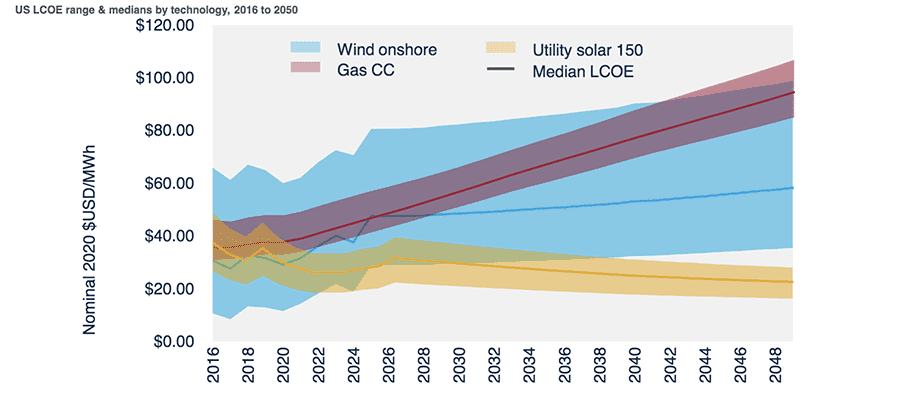As we enter into a new term of presidency, the focus now more than ever is on the future of solar, wind & gas, and how America will harness it going forwards. For the first time ever, almost 90% of new electricity generation from 2020 will be renewable, with just 10% being powered by coal and gas. The IEA expects green electricity to end coals 50-year reign by 2025.
While this is a huge breakthrough for the sustainable sector, America’s shifting use of energy will affect future solar, gas and wind pricing. Woodmac released a report at their 2020 Solar Summit that predicts the price fluctuations of the three renewable energy front runners between the years 2016 to 2048.
Solar, Gas & Wind Pricing Trajectory
Using levelized cost of energy (LCOE) indicators, the future trajectory of solar, gas and wind costs can be accurately predicted. According to the Woodmac report, US utility solar will be the cheapest source of electricity by 2048 on an LCOE basis, with gas set to be the most expensive. As wind is expected to have the largest price delta, it’s median LCOE price becomes significantly lower than gas’ as time progresses.

What Are Levelized Cost of Energy Indicators?
LCOE’s allow different technologies, such as solar, gas & wind, with unequal life spans, project size, capital cost, risk, return, and capacities to be compared. They calculate the present value of the total cost of a building and operating a power plant over the assumed lifetime of both.
The benefit of LCOE’s is that they measure value across the longer term, showing projected life-cycle costs, which could be considerably different from initial start-up costs. They can help inform decisions to pursue projects on an economic basis, by giving utility rate comparisons.
Why Will Solar Be Cheapest?
The installation of solar systems has boomed in the past 5 years, which has consequently reduced the cost of production. Largely helped by the Investment Tax Credit, solar fast became a main supplier of energy for both commercial businesses and private individuals. The huge success of the ITC saw it extend out until 2022, however it will be stepped down following 2020.
Although the Woodmac report predicts there will be a temporary spike in the utility cost of solar with the sunsetting of the ITC, it will still be significantly cheaper in 2048 compared to wind and gas. The cost of solar does not fluctuate drastically and the main expense is installation and upkeep. With the advancement of companies, such as EnergyLink’s, technology and installation capabilities, costs for solar are only set to reduce further.
Why Will Gas Be Most Expensive?
According to Vox, natural gas has always meant to be “the bridge” between solar and coal, while we work on scaling up renewables. Vox writes: “In its role as a bridge, natural gas seems to have a comfortable future. First, it will replace coal and nuclear “baseload” plants, and then, as renewables grow to supply the bulk of power, it will provide flexibility, filling in the gaps where variable renewables (wind and solar) fall short. By playing these multiple roles, natural gas will long outlive coal and prove useful well into the latter half of the 21st century. It will enjoy a long, slow exit.”
However, this trajectory changed in 2015, just five short years into the rise of gas, as complications became evident. Vox acknowledges: “first, wind and solar costs fell so far, so fast that they are now undercutting the cost of new gas in a growing number of regions. And then batteries — which can “firm up” variable renewables, diminishing the need for natural gas’s flexibility — also started getting cheap faster than anyone expected.”
The rapidly falling cost of wind and gas happened so fast that even now, in specific case studies, solar+storage or wind+storage is already more cost effective than natural gas plants. The issue for gas is that pricing is inherently volatile, while solar and wind power are controlled only by the cost of technology installation. With these set to fall in the coming years, it’s no surprise that gas will be the most expensive renewable by 2048.






